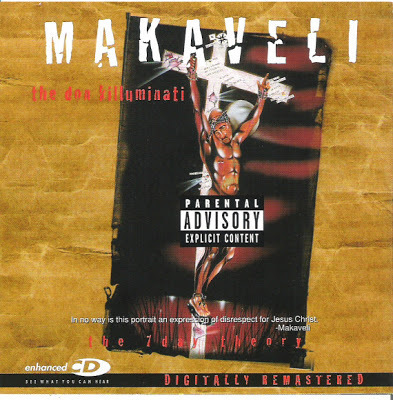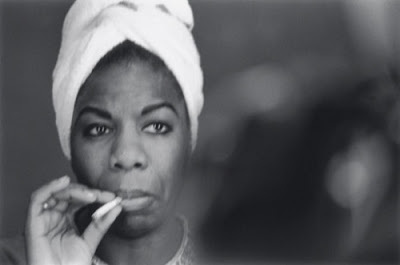Mark Anthony Neal's Blog, page 958
September 14, 2012
Ill Doctrine: Brother Ali Meets the Little Hater
Brother Ali speaks on his new album Mourning in America and Dreaming in Color, and the Little Hater in his head that almost stopped it from being made.
Published on September 14, 2012 10:52
Bomani Jones: NFL Replacement Refs Are Like Substitute Teachers
SBNation
The NFL replacement officials look scared on the field under the lights. They are listening to coaches too much and not laying down the law enough. They are acting like substitute teachers. Bomani and Jones brought in a real teacher to give some advice to the replacement referees.
Published on September 14, 2012 10:30
Awkward Black Girl - The Search (S. 2, Ep. 4)
iamOTHER J finally decides to search for a new job, but just when things are looking up, White Jay throws a curveball ...

Published on September 14, 2012 10:24
September 13, 2012
Syria's Children Cope with War and Daily Violence
Al Jazeera English
The conflict in Syria has raged on for so long - 18 months - that for children there, war is now the stressful norm.
For these children, political chants and the sounds of explosions are becoming a part of daily life, even as shortages in baby formula and vital medications mean surviving day to day has become a challenge in and of itself.
But now there are concerns that an entire generation of children could be left with psychological scars.
Al Jazeera's Sue Turton reports from the mountain town of Deir Sunbuul.
Published on September 13, 2012 18:39
Zoe Saldana and the Politics of Making Biopics of Artists of Color

Zoe Saldana and the Politics of Making Biopics of Artists of Color by Arthur Banton | special to NewBlackMan (in Exile)
Recently at HuffPost Black Voices writer Nicole Moore wrote an essay about why actress Zoe Saldana would be an insufficient choice to portray legendary singer Nina Simone in a biopic. Moore argues, the choice of Saldana was questionable due to physical characteristics of Simone, characteristics that Saldana physically does not possess. Moore further argued this action by the film’s producers is a continuation of Hollywood erasing dark-complexioned Black Women in film.
Moore’s assessment that Hollywood has an issue with dark-complexioned actresses of color has serious merit. You could extend the argument even further to include other creative industries such as music & television, and their penchant for lighter skin when it comes to female performers.
Saldana has been a lightning rod for discussion within the black community about the commodification and skin complexion preferences in Hollywood. Compounding the anger for some is that Zoe Saldana is not Black but a Latina, whose mocha complexion and ethnic features posit her in the body of a woman perceived to be Black. A great deal of Saldana’s success stems from her versatility as an actress and her aesthetics which have social capital. The responses to Moore’s essay have been profound including the creation of a petition at change.org addressed to the producers expressing displeasure at the decision.
My argument is that decision by the producers of the planned Simone biopic to cast Saldana was perhaps largely informed by the economics of the industry and the track record of previous high-profile bodies of work aimed at Black audiences. In other words, the economics of the industry is simple: get a positive financial return on the investment (few investors are in business to lose money). The cinematic industry (Hollywood and independent cinema) is a business, and history indicates the best chance of recouping that investment is to cast an actress with a successful track record of opening a film to which audiences have responded. Some of the critics who’ve expressed their thoughts on various blogs on the selection of Saldana have suggested boycotting the film.
Films about Jimi Hendrix, The Notorious B.I.G., and the cadre of black recording artists (Muddy Waters, Etta James, Chuck Berry) that were signed to Chess Records depicted in the film Cadillac Records have not filled the producers expectations at the box-office or with TV ratings. In fact, it appears that Sparkle (featuring the final performance of Whitney Houston) will join the ranks of films that Black audiences have boycotted or ignored. I’d be remiss if I failed to note that Tyler Perry’s most critically acclaimed films, The Family that Prey’s, Daddy’s Little Girls, I Can Do Bad by myself were also avoided and box-office disappointments in comparison to the movies featuring the infamous Madea character. Even one of the most positive films targeting Black audiences, Akeelah and the Bee, was also largely and sadly ignored at the box office.
So unfortunately, these examples and others have perhaps factored into the decision of why Zoe Saldana was selected to portray Nina Simone after their first choice, Mary J. Blige was unavailable (a point Moore even failed to acknowledge). Zoe’s talent is immense and certainly capable of delivering the acting performance this role certainly needs, equally, if not more importantly, she perhaps can draw a broader audience to the theater. Targeting just one demographic as opposed to casting a wider net for a broader audience could prove disastrous financially and hinder future biopics of black performers.
It appears the producers, might have taken into consideration Simone’s characteristics such as skin-complexion, ethnic features, singing ability that many people have addressed in their initial selection of Mary J. Blige. So the decision had to be made whether to pursue an actress or a singer (since a talent possessing both skill sets at a high level are rare) with name recognition that could bring people into the theatres and achieve a modicum of success like Lady Sings the Blues, What’s Love Got Do to Do With it, The Bodyguard, Dreamgirls, and Ray.
While other actresses such as Gabrielle Union, Viola Davis, Kimberly Elise, Jennifer Hudson and Queen Latifah might have delivered in some capacity the demands required of the role, (according to the producers), none were perfect, available, or have the star power and track record of Saldana (though Hudson would have been very intriguing choice). The criticism levied towards Saldana appears largely about her ethnic identity as an Afro-Latina of Dominican descent, born in New Jersey and less (ever so slightly) about her skin complexion which is lighter than Simone’s.
It’s rather interesting that throughout her career to this point, there were few opponents to Saldana’s roles (Drumline, Constellation, Guess Who, Star Trek) in which she portrayed an African American woman; but now that she’s the most high-profile, bankable woman of color in Hollywood (largely avoiding the racially stereotypical characters that African American and Latina actresses are often burdened), voices of opposition surface.
The films that Hollywood creates are a reflection of the consumption patterns of society. The films and themes that appeal to a broad demographic and make money will continue to be produced until audiences say otherwise. Black film audiences are not exempt from this model. The films that appeal and are consumed by mainstream Black audiences tend to revert to stereotypical character types that have been rooted in Hollywood since the inception of film but modified to contemporary tastes. In other words, Theodore Lincoln Perry, otherwise known as Stephen Fechit, whom at one point was the one of the wealthiest actors in Hollywood, but criticized for reinforcement of negative stereotypes has been repackaged in a variety of ways; now the financial rewards are greater with more avenues for spectatorship (via cable and satellite Television) and ancillary revenue from DVD and streaming video.
Another issue is that audiences do not interrogate what they consume, which can lead to the constant reproduction of style and aesthetics over substance. In the context of the Nina Simone biopic, this is not to say that Saldana isn’t talented, but in the eyes of the producers she has a broader appeal based on her track record with audience consumption patterns. The same racial logic that existed during Nina Simone’s era that limited her broad appeal still exists because the audience allows it.
Despite the negative responses, the producers should be commended for their desire on making a film about a singer who did not have the mainstream popularity of other Black artists whom deserve to have biopics made (Sam Cooke, Marvin Gaye, Michael Jackson, Lena Horne, Ethel Waters, Marian Anderson, Bert Williams, James Brown). More than a decade ago, when the late Gregory Hines portrayed the legendary Bill “Bojangles” Robinson—several shades darker—in the biopic Bojangles, there was few if any opposition to the much lighter-complexioned Hines. In the end, he delivered an Emmy-nominated performance and equally important, a story about one of the most heralded, highest paid, respected, Black performers in the history of entertainment was brought to the screen.
That alone is worth celebrating.
***
Arthur Banton is a Filmmaker and Ph.D. candidate in American Studies at Purdue University and graduate lecturer in the African American Studies and Research Center.
Published on September 13, 2012 15:44
Tupac Shakur, Jesus and Resurrection Power

Tupac Shakur, Jesus and Resurrection Power by Ebony A. Utley | HuffPost Black Voices
Jesus and Tupac had a lot in common.
Their dramatic early years began with conception under non-normative circumstances. Mary's mysterious virginal conception could have led her community to accuse her of adultery. Afeni Shakur's decidedly non-virginal conception occurred while she was out on bail. Afeni was accused of planning to bomb New York City public spaces. Neither woman was guilty of the accusations raised against them, but scandal still surrounded their pregnancies. The stress of the accusations was augmented by the fact that Mary was traveling while pregnant, and Afeni was imprisoned while pregnant.
Jesus was born into poverty in a manger in Bethlehem. Tupac was born into poverty in New York City. As poor minority babies, their families moved around a lot. Jesus' family fled to avoid the state-sanctioned oppression that was Herod's wrath. Herod wanted to kill Jesus simply because of who he was. Tupac's family moved in and out of shelters to avoid the state-sanctioned oppression also known as institutionalized racism. No one wanted to help Afeni because of who she was: a former member of the Black Panther Party. Both boys' stepfathers came from lineages filled with unscrupulous characters. There was no silver spoon for either child.
Under these circumstances, Jesus and Tupac matured into brazen intellectuals who spoke truth wherever there was injustice. They loved words and were master storytellers. As single men in their 20s who were self-taught and unemployed, they cared very little about others' perceptions and fraternized with sexually licentious women, cavorted with sinners, enjoyed a good party, appreciated good wine, had tempers, used profane language with religious people, praised faithfulness over stilted forms of religious piety and honored God more than the government.
Public demands for justice accompanied by a seeming disregard for social mores quickly placed Jesus and Tupac under constant surveillance. They were both betrayed and ultimately killed while still in their prime. Here's where the comparisons break down. Jesus was blameless. Tupac was found guilty of sexual abuse. And his body of work does indeed cosign plenty of immoral activities.
Despite many other obvious differences, comparing the particulars of Jesus and Tupac's lives creates broader implications for the relationship between religion and hip hop. Although they appear antithetical, religion and hip hop share immense potential for creating safe spaces where people who feel like outcasts can express themselves. Irrespective of whether you believe Jesus was the son of God or whether you believe Tupac was a thug, paying attention to religious influences in hip hop humanizes thugs. Paying attention to how hip hop uses religious themes humanizes religion.
For example, Jesus' resurrection must not be limited to the Christian narrative of death, burial, resurrection, ascension and promised return. Jesus is resurrected every time someone like Tupac can see a reason for his pain and persecution and decide to persevere. Tupac literally saw himself as Jesus.
Tupac intended no disrespect because Jesus helped him understand himself. When religious doctrines about original sin, eschatology and God seemed impractical, Tupac found hope in a Jesus who understood oppression as well as the inevitability of death. In fact, Tupac and the Outlawz rapped in "Black Jesuz" about a not-too-perfect saint who hurts, smokes, drinks, understands their pain and carries them through hard times.
As I write in my book "Rap and Religion: Understanding the Gangsta's God":Gangstas who depict death as a way of life are drawn to crucified Jesus not because they want to die, but because staring down death makes them feel most alive. According to cultural critic and minister Michael Eric Dyson, gangstas see a crucified black Jesus as "the God who literally got beat down and hung up, the God who died a painful, shameful death, subject to capital punishment under political authority and attack, but who came back, and keeps coming back, in the form and flesh we least expect."
Resurrection power is the ability to live in the midst of death. Jesus is immortalized by humanity in the same way that, 16 years after his death, Tupac's is immortalized within the hip hop community.
Tupac was the first rapper to depict himself on a cross, but he was not the last. Many rappers have depicted themselves as Jesus crowned with thorns, and many more have appropriated the themes of return, rebirth and resurrection.
Hip hop's affinity for Jesus encourages resurrection as a form of resistance when religious platitudes fail. Although it may appear blasphemous, hip hop heads push the boundaries of religion until they arrive at Jesus -- an accessible model -- for surviving oppression. Jesus is a cultural icon for resisting the rules, especially those for life and death. By imitating a Jesus who suffered and yet emerged victorious over death, they boldly appropriate Jesus' resistance as their own.
***
Ebony A. Utley, Ph.D. is an associate professor of communication studies at California State University Long Beach, and the author of "Rap and Religion: Understanding the Gangsta’s God."
Published on September 13, 2012 15:09
As U.S. Inequality Widens, Cornel West and Tavis Smiley Launch Poverty Tour 2.0
Democracy Now
New government data shows economic inequality continued to widen in the United States last year. The Census Bureau reports the wealthiest Americans increased their share of total wealth by 4.9 percent, while the median income reached its lowest level since 1995. Some 46.2 million Americans were classified as living in poverty.
We're joined by Tavis Smiley and Cornel West, who are attempting to start a national dialogue with their new Poverty Tour 2.0 visiting four battleground states: Ohio, Virginia, Pennsylvania and Florida. West is a professor at the Union Theological Seminary and prolific author. Smiley is an award-winning TV and radio broadcaster who hosts the PBS TV show, "Tavis Smiley." Together they are co-authors of the book, "The Rich and the Rest of Us: A Poverty Manifesto."
Published on September 13, 2012 08:49
What More Can I Say?...Remembering Nina Simone

The State of Things w/ Frank StasioWUNC Nina Simone…What More Can I Say? Nina Simone was born Eunice Kathleen Waymon in Tryon, NC in 1933. She was musically gifted from a young age and her experience singing gospel in the church influenced her jazz performance style that would later make Simone an international superstar. Simone also lent her voice to the Civil Rights Movement with powerful, socially conscious songs like “Young, Gifted and Black” and “Mississippi Goddamn.” While she found success as a performer and activist, Simone also suffered from mental illness, which tore apart her personal relationships. The Sonja Haynes Stone Center for Black Culture and History at the University of North Carolina at Chapel Hill is celebrating the life and legacy of Nina Simone this week. There is an exhibition of Simone’s letters and rare photographs and the debut of an original, one-woman play called “Nina Simone…What More Can I Say?” Host Frank Stasio discusses the power of Nina Simone’s voice and personality with Nadine Cohodas, author of “Princess Noire: The Tumultuous Reign of Nina Simone” (UNC Press/2012); Sam Stephenson, Lehman-Brady Joint Visiting Professor of Documentary Studies and American Studies at Duke and UNC-Chapel Hill; Joseph Jordan, Director of the Sonja Haynes Stone Center; Howard Craft and Yolanda Rabun, the playwright and star of “Nina Simone…What More Can I Say?” Listen Here
Published on September 13, 2012 08:30
September 12, 2012
Vijay Prashad on Death of US Ambassador in Protest of Anti-Islam Film in Post-Gaddafi Libya
Democracy Now
The U.S. ambassador to Libya has been killed along with three other embassy staff after protesters stormed a consular building denouncing an American-made film insulting the Prophet Muhammad. Ambassador Christopher Stevens is reportedly the first U.S. envoy to be killed abroad in more than two decades. We speak to Vijay Prashad, professor at Trinity College and author of "Arab Spring, Libyan Winter."
Published on September 12, 2012 09:45
Mark Anthony Neal's Blog
- Mark Anthony Neal's profile
- 30 followers
Mark Anthony Neal isn't a Goodreads Author
(yet),
but they
do have a blog,
so here are some recent posts imported from
their feed.



